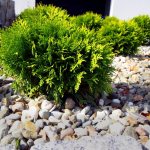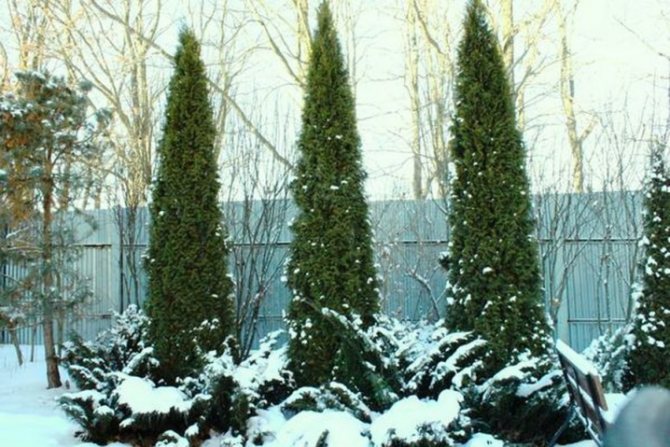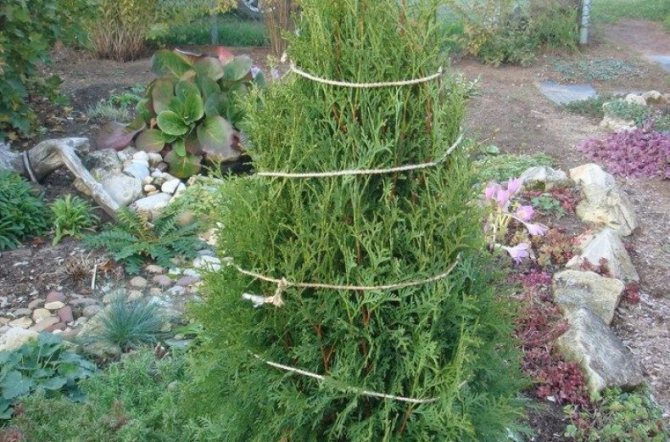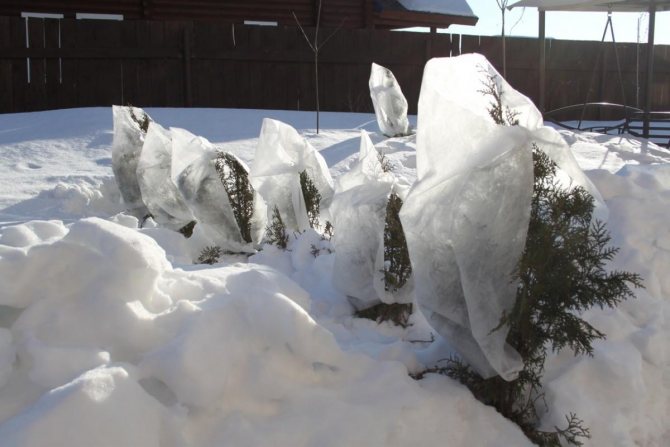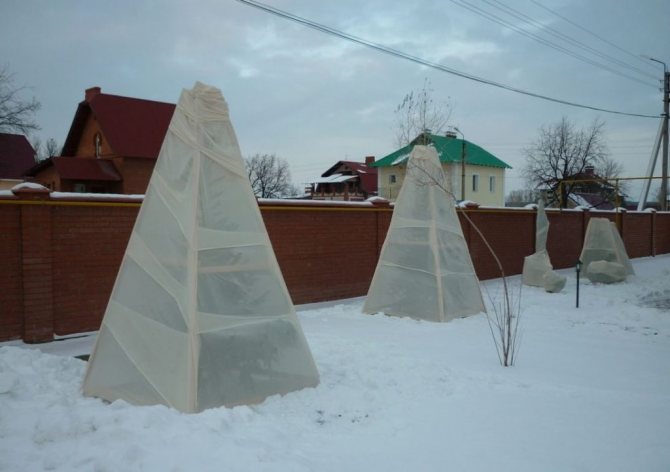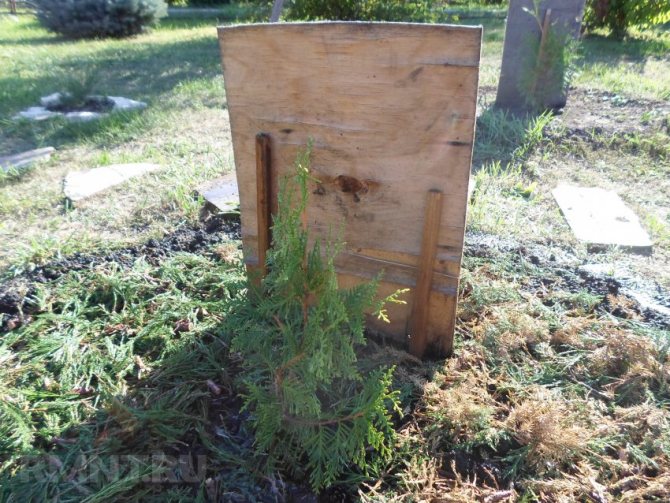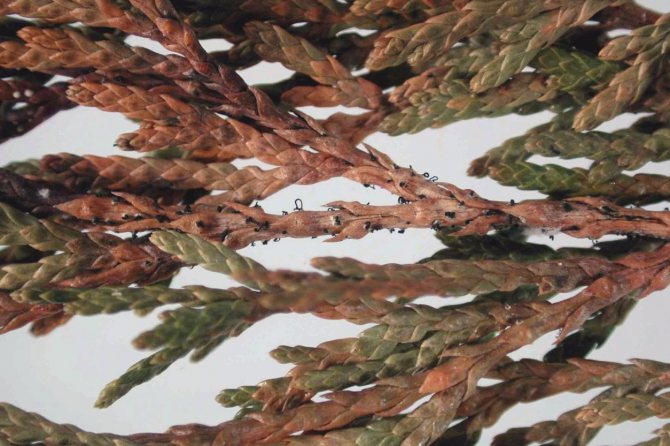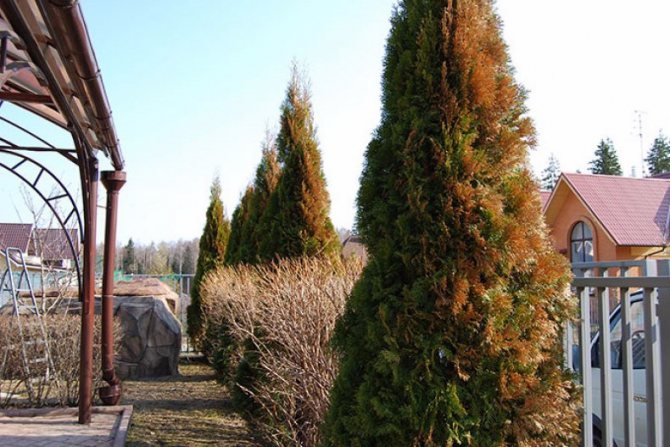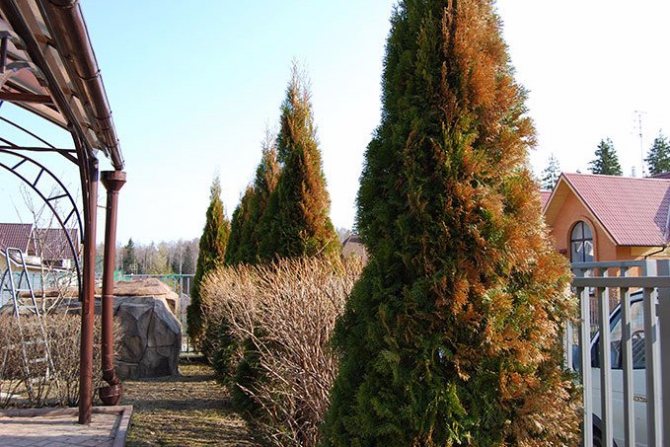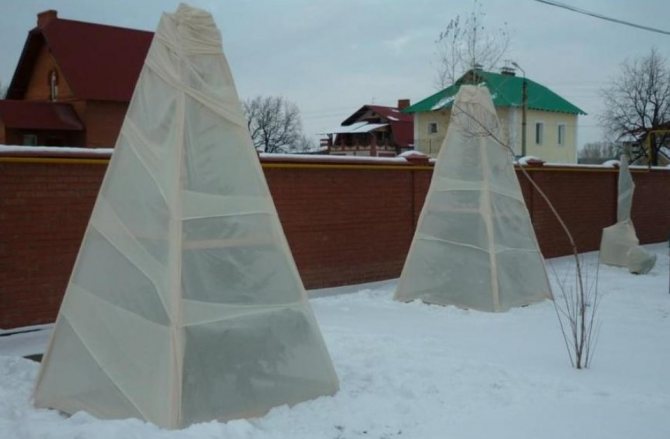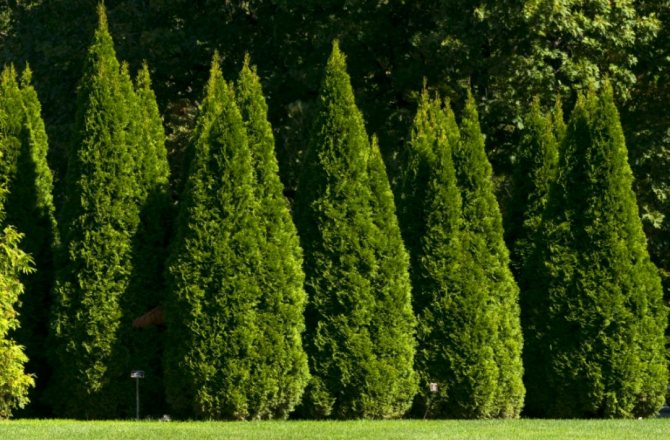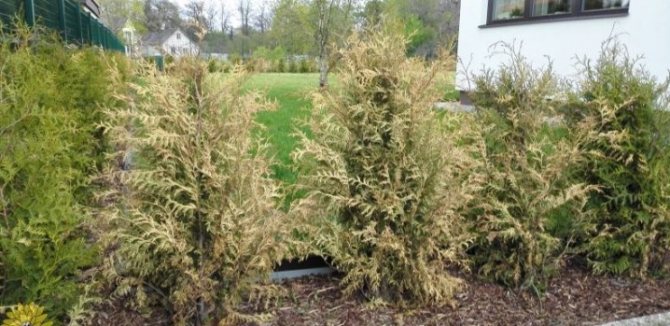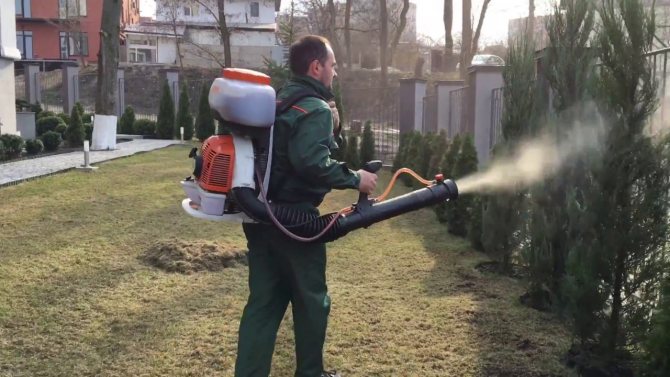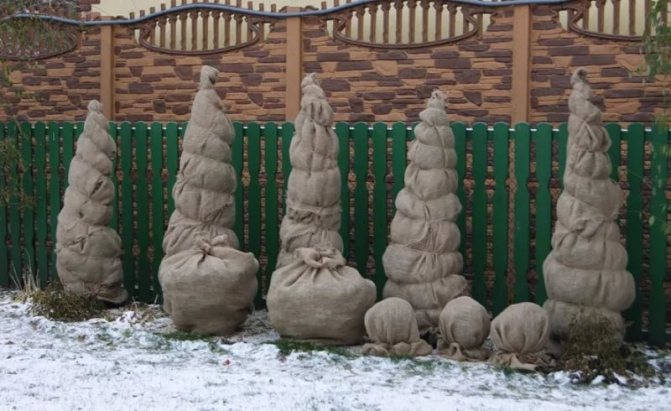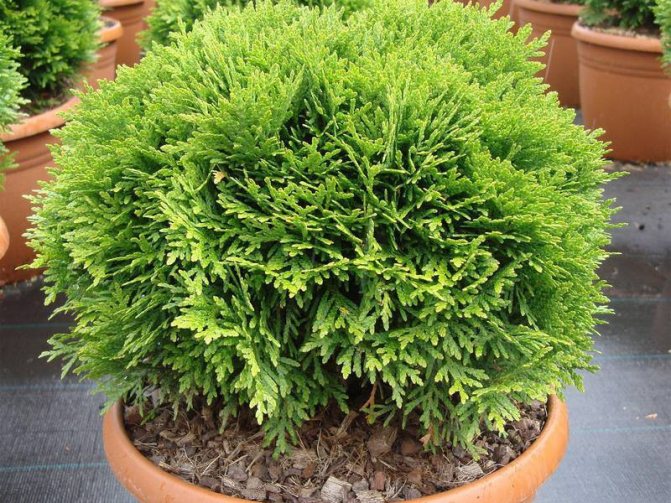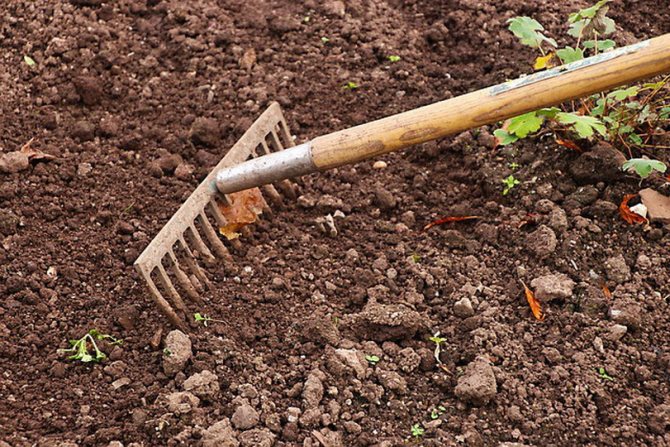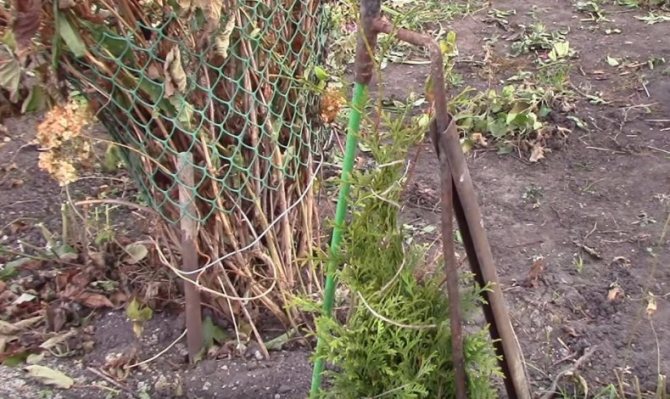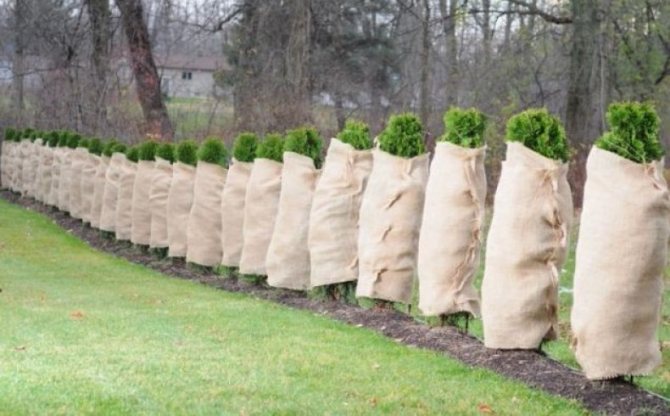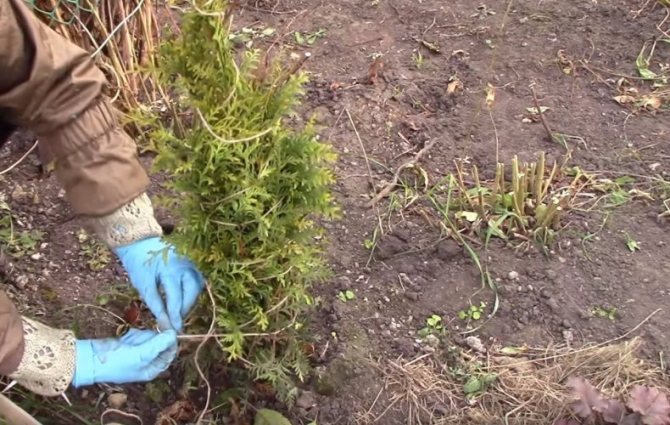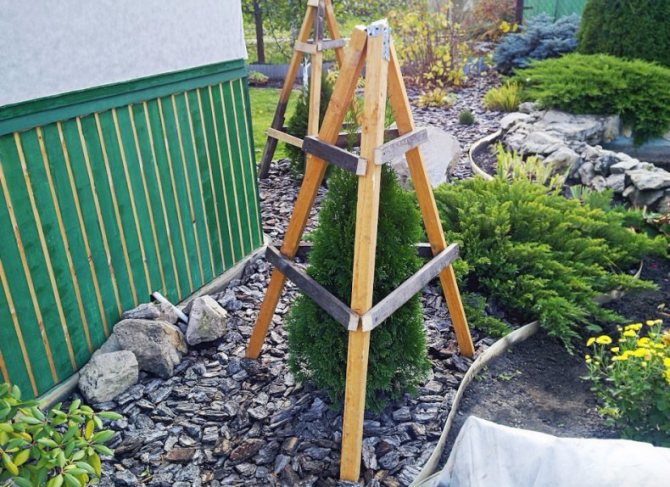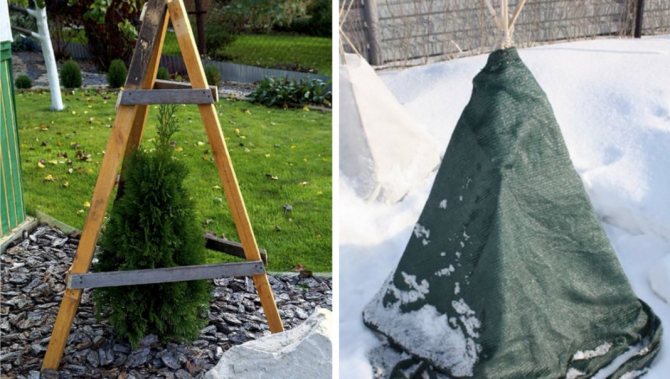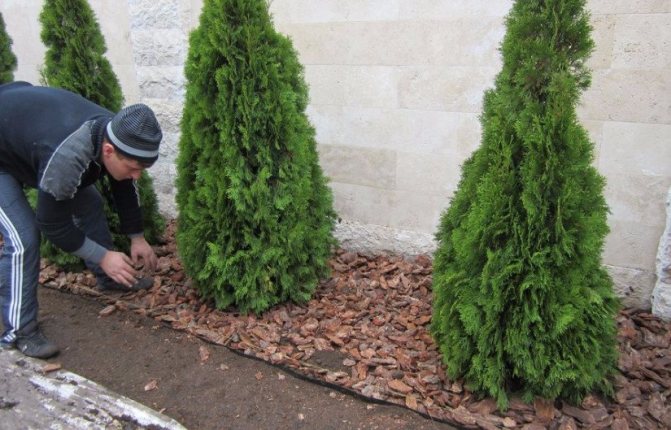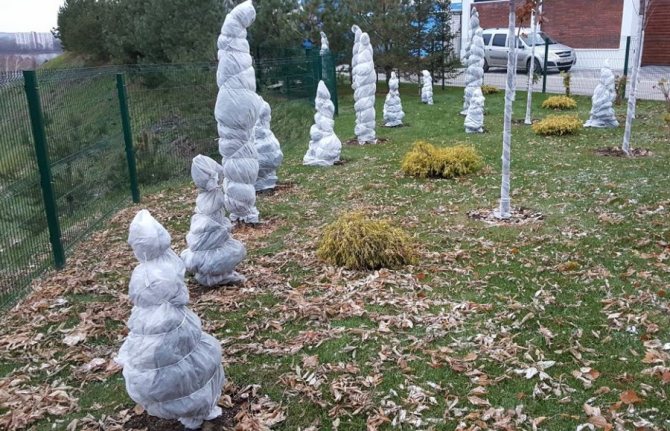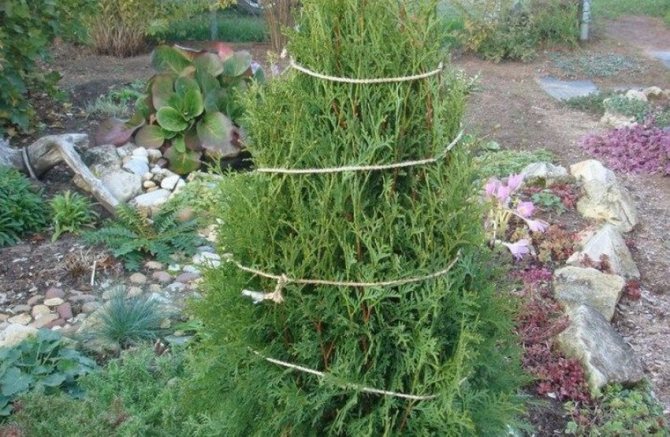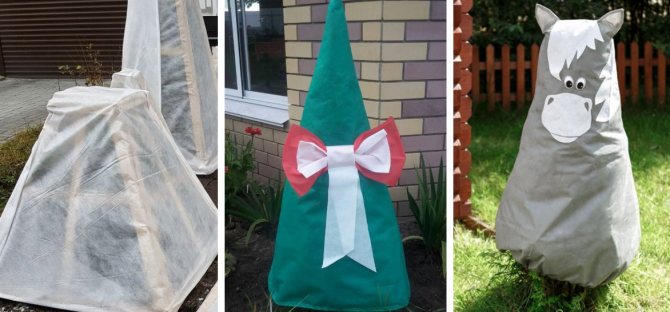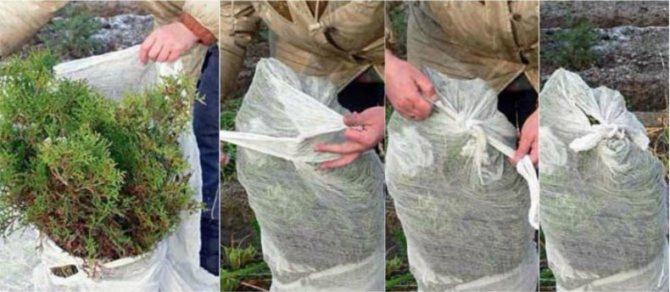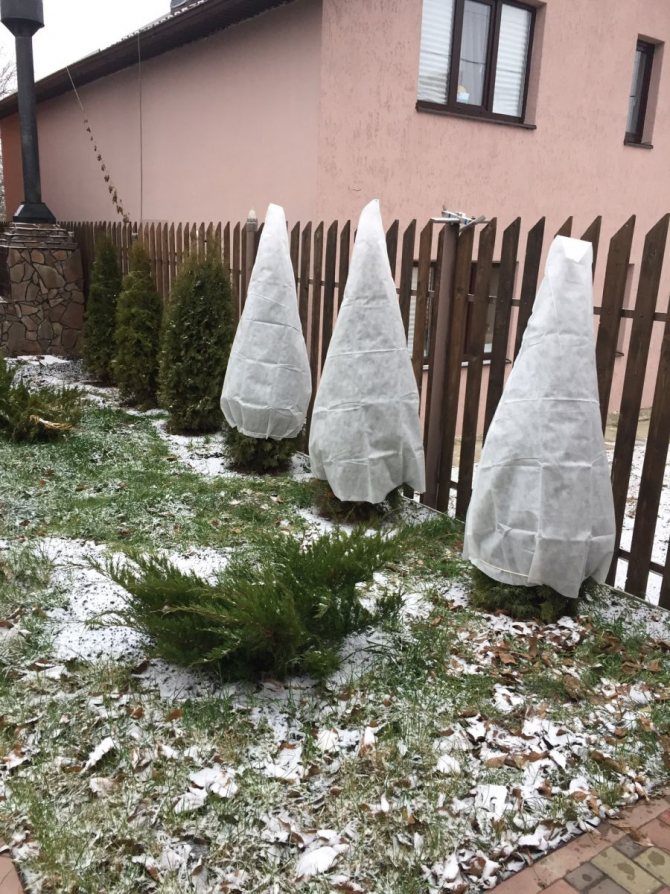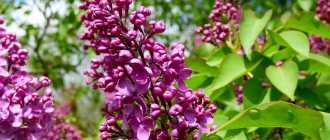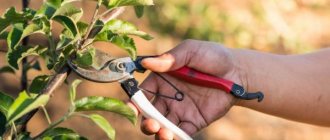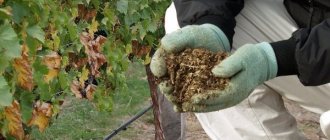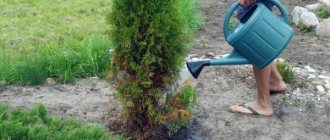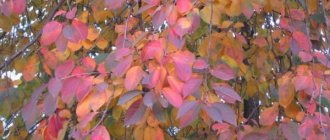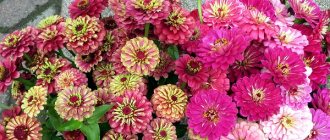Bushes and trees
0
140
Article rating
Everyone wants to devote a minimum of time to caring for the garden, but at the same time, so that it remains beautiful and delights everyone around. To make this dream come true, there is a solution - give preference to the slowest growing varieties of evergreen conifers. Thuja Danica is considered one of the best.
Thuja western Danica - easy-care and attractive ephedra
Autumn care for thuja
With proper care in the fall and the necessary operations to prepare the plant for winter, you will provide it with the necessary conditions for successful wintering. What you should pay attention to:
- Plant feeding.
- Stimulation of the root system.
- Watering.
- Pruning.
Stopping the application of nitrogen fertilizers
In the fall, you should stop feeding the thuja with nitrogen. This fertilizer stimulates the formation of young shoots. By the beginning of cold weather, they will not have time to get stronger and may die over the winter. Top dressing with this fertilizer should be carried out for the last time in mid-August.
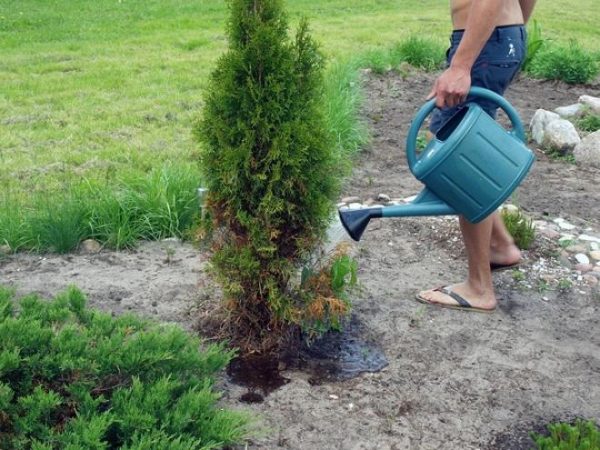
Root system stimulation
Another, no less important operation that you must carry out in order to properly prepare the thuja for winter is to stimulate the root system. Not everyone needs it, but only young shoots and those plants that were transplanted to a new place before winter. To do this, treat the shrub with drugs that stimulate root growth: Kornevin or Zircon. Dilute the preparations in 10 liters of water: Kornevin - 10 g, and Zircon - 40 drops. Water the tree with the resulting solution. A few days after this procedure, it is required to water the bush with 30 liters of water, pouring it into the trunk circle. This procedure is needed to drink moisture from the roots and prevent them from freezing.
Watering
If the region in which you live is characterized by autumn without a lot of rainfall, then you should regularly water the thuja. The coniferous bush loves moisture, but keep in mind that its excess will lead to decay of the roots. Water the plant abundantly before winter. Then the moisture will saturate the roots for a long time, and the frozen ground around the bush will protect them from hypothermia due to the longer freezing of the soil.
Pruning
Pruning is another essential step in the fall of your coniferous tree. It provides him with healthy development and beauty of form. It is very important not to overdo it when pruning a coniferous bush in the fall. If you bare him too much, then he will not have time to recover and may not endure the winter cold.


What is pruning for? You need to prune, first of all, to remove dry and diseased shoots. Untimely processing can lead to the death of the entire thuja.
It so happens that not all of the branch is affected, but only a small part of it. Then you shouldn't delete it completely. Cut off only the affected part. You can only run your hand along the branch, and the dried, diseased needles will fall off by themselves. You may well expect that in the place of the fallen, healthy needles will grow and the tree will be saved.
Additionally, the thuja is cut to correct the shape. To keep the bush in its original appearance, cut off the trunks that have grown strongly upward. This will also allow the side branches to grow. By pruning the tree, you create good air circulation and protect it from pests.
Thuya tolerates procedures for removing unnecessary processes well both in spring and autumn.Nothing bad will happen if you prune a third time. There is no clear time frame for trimming. The main condition that you must adhere to when processing a plant is dry weather without precipitation and an air temperature of +4 degrees.
It is important to properly trim the thuja. To do this, follow these steps:
- Remove any dried, insect-damaged branches from the top of the coniferous bush.
- Cut off any sprouts that have come out upward.
- Remove excess branches from the inside of the plant.
You can shape any shape of the coniferous bush you want. Purchase a metal sculpting mold from your garden supply store and place it over the plant. When the free spaces are filled with shoots, remove the shoots protruding upward. This manipulation is called topiary haircut. In addition to it, there is a spherical and spiral pruning. These types of haircuts are carried out in the likeness of topiary pruning: the branches that stick out upward are removed until the bush acquires the desired shape.
How to keep thuja in a pot
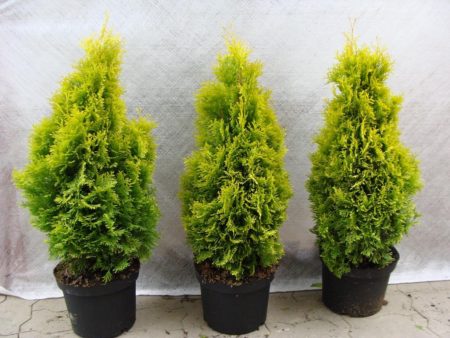

If your thuja is still small, then it is probably still sitting in a pot. Then there will be no problems with shelter, just with the onset of severe cold weather, remove the tree from the street to a cool room, put the pot with the plant in the basement, cellar, or take it out to the glazed balcony. The optimal temperature range for thuja wintering is considered to be from 4 to 10 degrees Celsius. Check that there is no high humidity in the room, and that the plant itself is well spilled and wrapped with craft paper. It is desirable that there is a light source in the room, for example, a small window. You can move the thuja to a cool room for the winter, but just keep the plant away from radiators and open the window for fresh air.
Do I need to feed the thuja in the fall
Thuja does not need special fertilization in autumn, except for the time after pruning the tree: then it should be fed. After these manipulations, the plant is weakened and must be carefully examined. If you notice pests: false scale insects or aphids, be sure to spray the bush with preparations to protect conifers from insects. After you have pruned the crown, feed the thuja using the following fertilizers:
- siderates;
- manure;
- complex mixtures for conifers.
The main thing to remember when feeding is a sensible measure. A large amount of fertilizer can lead to the death of the plant. This is explained by the fact that feeding strongly stimulates the development of the tree. Young roots and newly formed shoots are not able to withstand the cold and thuja can simply die.
The safest form of plant feeding in the fall is fertilization with peat, wood ash or compost. This type of feeding enriches the soil in which the thuja grows well, and at the same time is correctly perceived by the tree: fertilization does not lead to the active formation of young shoots.
Insulation of roots
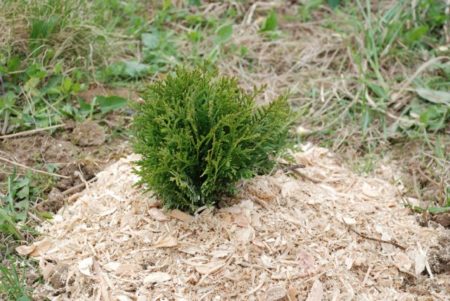

In addition to keeping the crown warm and from sun protection, you need to think about how to insulate the root system. The roots of young plants are exposed to frost, and the plant itself will quickly die if the roots are frozen. Suitable for warming the root system:
- peat or any other organic component. The main condition is that the mulch must have a loose layer;
- a mixture of fallen autumn leaves with earth or humus. In addition to protection from cold weather, such a mixture will eventually become an excellent fertilizer for the root system;
- sawdust, straw.
The thickness of the mulch layer should be at least 5 cm, but not more than 10 cm. The mulch is placed near the tree trunk circle, and the lapotnik is laid on top of it. It will protect the root system from rodents and press down on the mulch.
Actions to prepare thuja for winter
Thuja is considered a frost-hardy coniferous tree.The exceptions are decorative varieties and recently planted trees that have not yet gotten stronger. With them, you should carry out the actions necessary to protect against low temperatures. After proper care for the thuja in the fall, it is necessary to prepare it for the winter.
- Insulate the soil with mulching. To do this, dig up the soil close to the plant's trunk, remove all weeds and apply protective material. Suitable mulch: compost, manure, dry leaves, straw. The height of the insulating layer can reach from 10 to 30 cm.
- Insulate the bushes. To do this, you need to lift the branches of the plant up, pressing them against the trunk and securing them with a wire or rope. Put a bag of light colors on top of the bush: photosynthesis processes take place all year round, so the plant needs a constant source of sunlight, otherwise it may turn yellow. The protective material should not fit snugly against the wood. This is necessary for constant air circulation.
- Use 5 liter plastic containers to cover the young tree. Cut off the bottom of the bottle and place it on top of the coniferous tree.
- Preventing bark burns is another important step in caring for thuja and preparing it for the winter. To do this, starting from February 15, from the side of an active source of sunlight, install shields near the tree.
The insulation is removed immediately after a stable positive temperature is established.
Reproduction
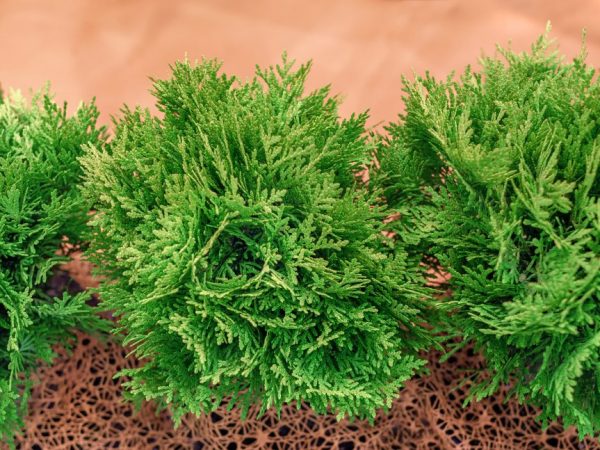

Danica variety can only be propagated by cuttings.
It is impossible to propagate by seeds - they are sterile. This variety propagates only by cuttings cut in a special way - "with a heel" (part of the main stem with a dormant bud) from the mother plant.
The stalk 5 cm from the base is cleaned of needles and placed in a root solution for several hours.
Then they are placed in loose moist soil, consisting in equal parts of peat, leafy earth and sand.
A cut plastic bottle is put on top to maintain constant moisture. To prevent decay, the plantings are regularly ventilated. It can be removed after 3 weeks.
Features of the regions
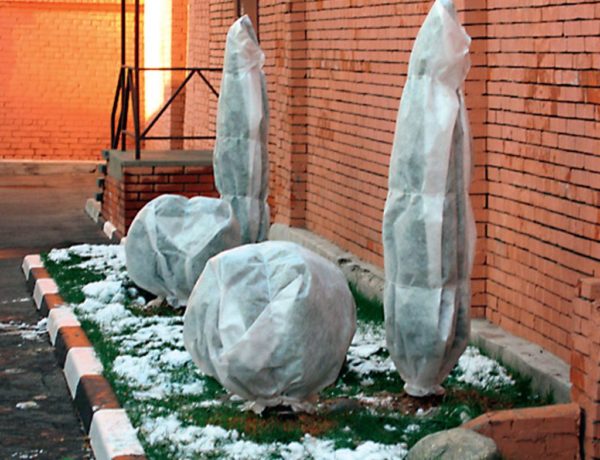

The shelter scheme for thujas for the winter may differ. It depends on the region in which the coniferous bush grows. For example, in the Middle Lane, the thickness of the mulch should be 15 cm. After warming the soil, all the necessary actions are taken to protect the crown of the plant.
In the Volga region, the difference in the preparatory procedures for the winter is to increase the thickness of the mulch by 6 cm.That is, the protective soil layer should be 21 cm.
On the territory of the Urals and Siberia, a large amount of snow falls, which can damage the thin branches of the thuja. To protect the bush, before covering it with a protective layer, build a frame made of tapered wire. This will prevent heavy snow from settling on the plant.
How to cover thuja
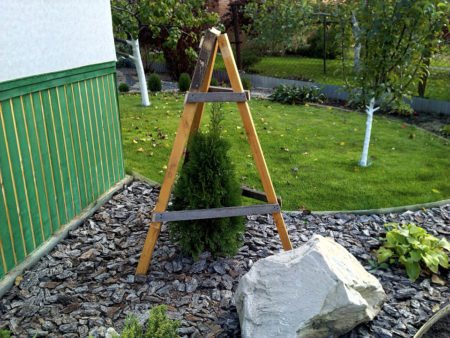

Shelter of a thuja for the winter is a simple process, but a little painstaking, since accuracy will be required. Tie the branches of the tree with a thick twine to begin with. Do not overtighten the twine, otherwise it will be difficult for the branches. It is enough to fix the crown so that the snow cannot fall on the branches. Gather the branches up towards the center of the tree, and then start tying in a circle. Start the process at the base of the tree and gradually work your way up to the top.
If heavy snow falls in your area with the onset of winter, it makes sense to build a frame. It is necessary to drive 3 pins made of metal or wood into the ground next to the crop. They should intersect at one point - above the top of the tree. Then wrap the frame with an air-permeable covering material. Be sure to reinforce the material to the frame so that it will not be blown away by the wind gust. Tie it with twine, for example.


In stores that offer a large selection of garden tools, sometimes there are special covers for plants on sale.Get them, they are easy to use and will serve you for more than a dozen years. The cover just needs to be put on and straightened on the thuja, then the plant will stand wonderfully all winter, until the beginning of spring. In the spring, remove the cover, wash and dry; you will not need it until autumn.
Another way to hide is by installing a sunscreen. It can be a wooden box or a homemade device. Drive the pegs into the ground parallel to each other. Cover the space between the pegs with roofing material and a special sun-protection cloth. Such a shelter will prevent the needles from burning out even in spring, when the sun is very active.
To protect thuja in winter, use a few good tips:
- annual and biennial trees are covered first, even before the snow falls;
- if a lot of snow fell during the winter, remove it from the shelter;
- the shelter can be removed after the snow begins to melt.
It is more convenient to cover the tree with two or three people. Ask someone in your family to help you, and you will be done in just a few minutes.
Mistakes to Avoid in Autumn Care
The following mistakes when preparing a thuja for winter can lead to its damage and death, so when caring for a tree, you should definitely know them.
- When does winter come? do not cover coniferous trees with protective material.
- The tree is not protected from active sunlight by shields.
- Instead of fertilizer for conifers, which you need to feed thuja, use preparations for deciduous trees.
- Pruning during the period of active sunlight. This leads to the fact that the needles acquire a brown tint.
Correctly caring for an evergreen beauty in the autumn period will not be difficult. This does not require special knowledge and special skills. It is necessary to perform all of the above simple steps to care for this coniferous tree in the fall, be sure to cover the crown of the bush, as well as insulate the soil for the winter. Then this coniferous tree will decorate the personal plot, delighting with eternal greenery for many years.
Overview of varieties
Danica is represented by two types:
- traditional (Thuja occidentalis Danica);
- gold (Thuja Aurea Danica).
Traditional thuja
This ephedra has a dark green color; it acquires a bronze tint by winter. In spring, when the temperature rises, it returns to its original color.
Young plants look somewhat disheveled, fluffy: juvenile needles grow in different directions.
Over time, the needles turn into scales that fit tightly in the branch. The crown looks homogeneous, dense, shiny.
The shape becomes spherical, its dimensions are:
- up to 100 cm wide;
- up to 80 cm in height.
Golden thuja


The plant will decorate your site
Tuya Danica Aurea is even smaller:
- maximum height - no more than 80 cm;
- width - up to 90 cm.
The needles are of a very spectacular golden-green color, in which yellow shades appear with winter cooling.
In the sun, Danica Aurea is dominated by yellow tones, in the shade - green.
The advantage of this species is its high winter hardiness - up to -30 °. However, the golden thuja does not withstand the spring rays at all, it requires shelter from sunburn.
Features of autumn care for thuja
The main measures for the care of an ornamental plant in the autumn are aimed at strengthening immunity and preparing for winter frosts. In order for the ephedra to easily survive the winter, it must be provided with the correct agricultural technology.
Thuja watering mode in autumn
The culture planted in the autumn period needs irrigation measures and sprinkling in volumes equivalent to those of spring seedlings. A young plant badly needs a sufficient amount of moisture, which has a positive effect on overwintering.If in autumn there is a sufficient amount of atmospheric precipitation, then irrigation should be reduced to almost a minimum or stopped completely.
Too much moisture, which for a couple of weeks affects the root system of a plant, often becomes the main cause of damage to the culture by pathogenic microflora or death.
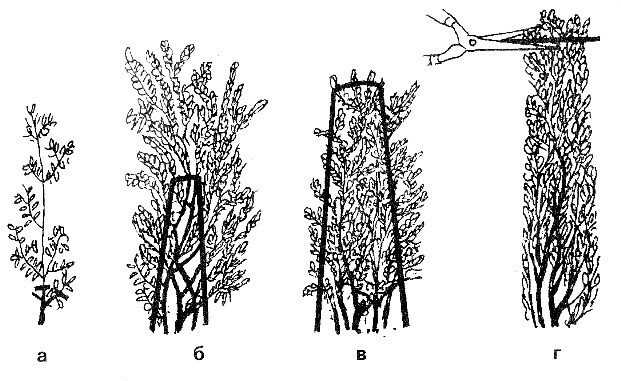

Scheme and technology for pruning thuja in the fall
Pruning should only be done in dry weather. The aerial part can be trimmed to a pyramidal, columnar or spherical shape, and the Smaragd variety is most often used for spiral and chess garden figures. A careful examination of the crown and a visual determination of the desired shape of the aboveground part of the ephedra are preliminarily performed.
You cannot cut the branches immediately after rain, as in this case there is a risk of pests and various diseases appearing on the crown. To give an arched and rectangular shape, special blanks or twine are used. All tools that are used for trimming must be sharp and clean.
Thuja autumn feeding rules
There is absolutely no need to fertilize the plant immediately after planting in a permanent place if all the appropriate fertilizing and fertilization have been applied to the planting pit. The best option is feeding in spring or summer.
In areas characterized by poor soils, plants need to be fed with full-fledged complex fertilizers. In the autumn, it is not recommended to feed the plants, since in this case there is an excessive development of shoots and twigs that do not have time to fully form by the winter cold. Such conifers often die in severe frosts.
Description of the plant
Thuja western Danica was bred in 1948 by Danish breeders and named after Denmark, it has firmly entered the set of reliable landscape design tools.
A small unpretentious bush will not take up much space on the site, but will make it elegant and stylish without a lot of time and effort.
Evergreen ephedra with slow growth and natural spherical shape. The growth rate is no more than 4-5 cm per year.
By the age of 15, it reaches the parameters declared by the breeders, after which it can live up to 150-200 years in an unchanged state.
Description of the plant:
- dense shiny crown;
- vertically directed short branches;
- the needles are small, soft;
- compact size.
Danica blooms rarely, the cones are very small (up to 0.6 cm), rounded, brown in color. They do not in the least spoil the decorativeness of the thuja.
Preparing thuja for winter
When preparing an ephedra for winter frosts, it is very important to adhere to standard terms, which vary depending on the soil characteristics and climatic conditions in the region where the ornamental ephedra is grown.
How and when is the shelter of the thuja for the winter
Before deciding on the need to use a shelter in the winter, you need to decide on the age and time of planting the ephedra. If an ornamental plant was planted in the spring or summer period of the current year, then it belongs to the category of young crops in need of protection.
Mature and sturdy plants may well do without shelter., if planted in the shade of large trees or next to a house and a high fence. It is imperative to cover the above-ground part of the bush at temperatures below -35 ° C. To protect the crown, light and breathable covering materials or traditional burlap should be used.
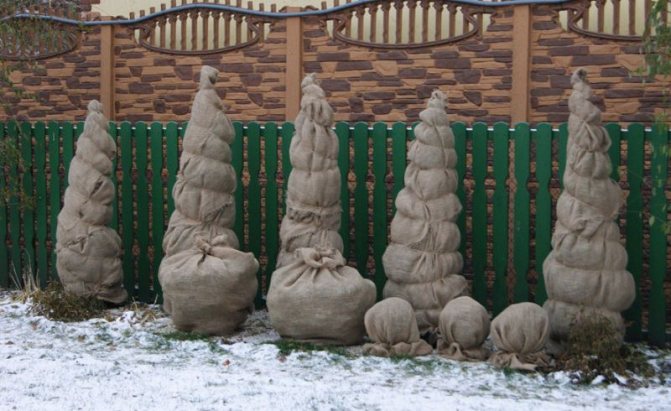

Why and how to tie the thuja in the fall
In preparation for winter snowfalls, the crown of young and adult thuja must be tied very carefully with a nylon rope or twine, which will prevent the fluffy branches from breaking off under the weight of the snow mass. Tie the crown of the ephedra not too tightbut very weak strapping is completely ineffective.
Preparing the root system of thuja for wintering
The root system of thuja, regardless of age, is characterized by compactness and rather superficial location. It is because of its botanical features that the roots of the ephedra are able to freeze out in winters that are too frosty and with little snow, as well as overheat in the hot summer period.
To prevent freezing and overheating, it is necessary to carry out high-quality soil mulching in the autumn and spring. Such an agrotechnical technique also allows you to retain a sufficient amount of moisture in the surface layers of the soil, well maintains the soil in a loose state, and also prevents over-active growth and development of weeds.


Digging and mulching of trunk circles
Shallow digging and loosening, followed by mulching of the soil, makes it much easier to care for the ornamental crop. Such events must be performed without fail not only in early spring, but also with the onset of autumn.
No soil crust forms under the mulch, and the soil itself receives effective protection from erosion during irrigation activities. Mulching can be done with garden compost, fallen leaves, low-lying peat, wood chips and sawdust, as well as other organic ingredients.
Landing
Danica belongs to unpretentious plants, however, there are mandatory operations, without which she will not be able to reveal her potential.
The choice of planting material
The safest way to buy seedlings is from specialized nurseries:
- the likelihood of purchasing a mis-grading is reduced to zero;
- constant supervision of high-level specialists ensures high quality of planting material;
- the opportunity to receive professional advice on planting and caring for purchased trees.
Of the two options - with an open root system or with a closed one - it is better to choose seedlings in a container. The survival rate is almost 100%.
Danica price depends on:
- height (the price increases every 10 cm, so thuja grows very slowly);
- the time of purchase (it is more optimal to plant in spring, therefore, seedlings are cheaper in autumn);
- varieties (The golden variety is more expensive than the traditional one, because it is more spectacular in appearance and more resistant to frost);
- places of purchase (in the southern and western regions the cost is less than in Siberia and the Far East).
Prices in nurseries of Central Russia:
| Thuja height (cm) | Price, rub.) |
| 15-20 | 900 |
| 20-30 | 1 500 |
| 30-40 | 2 200 |
| 40-50 | 3 300 |
Preparing the landing site
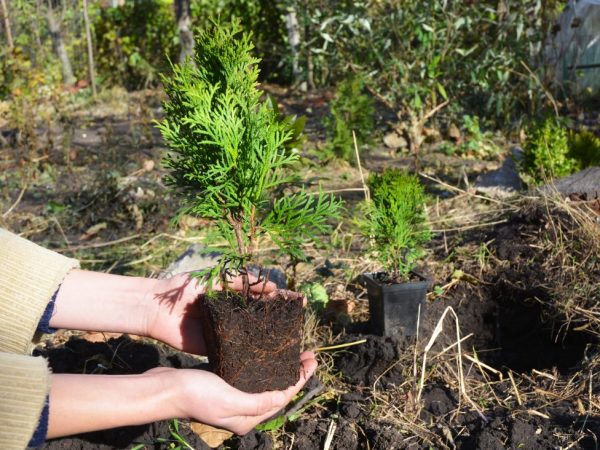

The seedling must be planted in a windless place.
Culture is demanding of the sun. The variety belongs to shade-tolerant, however, with a lack of lighting, the crown becomes loose, "shaggy".
Danica Aurea especially suffers in partial shade - she loses her golden hue (turns pale).
It is preferable to choose the soil fertile, loamy, with an acidity index from 5 to 7.
Thuja does not tolerate long and strong winds, therefore it is important to provide for the protection of the site from drafts.
Roots - superficial, fibrous, nearby trees with a powerful root system will oppress it, inhibiting growth and development.
The moisture of the earth is important, but the plant survives a short-term drought better than constant waterlogging. Therefore, the landing site must be chosen without a close approach of groundwater.
Landing technology
Thuja is planted in early spring or autumn, a month before the onset of constant frosts. It is preferable to carry out the procedure in the spring, during the summer the tree will get stronger and better take root.
If the seedling is in a container, then the planting time can be any, it is important to have time to do this before the cold snap.
The planting hole is prepared in a day so that the earth has time to settle. In size, it is made 10 cm larger than the lump of the seedling.
A 20 cm drainage layer is placed at the bottom of the well:
- broken brick;
- expanded clay (large fraction);
- pebbles.
The pit is filled by 1/3 with fertile light soil of the following composition:
- 2 parts of leaf or garden land;
- 1 part sand;
- 1 part peat;
- 2 tablespoons of complete compound fertilizer.
Plants with an open root system are soaked for 40-60 minutes in a solution of any root former before planting, after which the roots are carefully spread in the pit and covered with the remaining soil.
Plants with a closed root system are planted by transshipment, trying not to damage the earthen ball.
Important! The root collar should be at ground level.
Watering the seedling during planting is necessary in 2-3 steps, constantly compacting the soil after watering in order to remove air voids.
Autumn problems and methods of solving them
Failure to comply with the cultivation technology and violations in the care regimen often cause problems in the fall. A diseased plant may shed needles or turn very yellow.
How to crop thuja in autumn (video)
For what reason does thuja shed its needles in the fall
There are several reasons for the needles to fall, but the most common and easily identifiable categories include:
- too strong and prolonged frosts, which have an extremely negative effect on the appearance of the crown of not too frost-resistant varieties in the absence of high-quality insulation;
- severe drought in the autumn in the absence of high-quality freezing measures and drying out of the root system;
- sunburn, which severely burns the youngest and most recently planted plants, in the absence of shading;
- too late and abundant application of chemical fertilizers, causing burns to the root system.
Among other things, an ornamental culture can be affected by some diseases and plant parasites, including phytophthora, brown shoots, rust and shute, thuja false shield, thuja moth, wireworm, thuja bark beetle and spider mites.
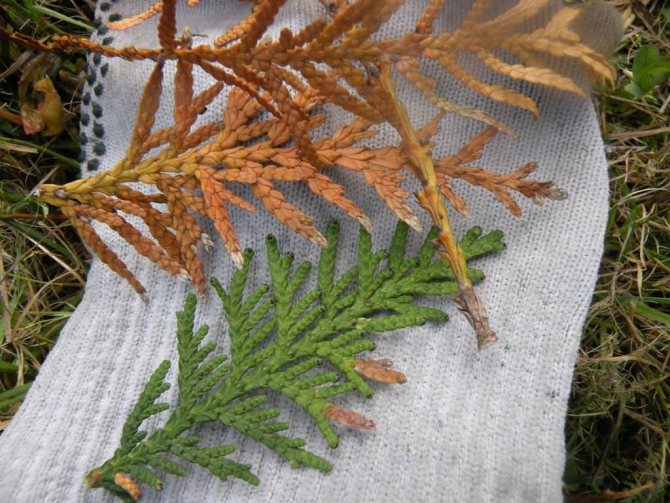

For what reason thuja turns yellow in autumn
The natural browning of the ephedra crown is often observed at the end of the growing season with the onset of late autumn. In this way, the plant adapts to the upcoming low-temperature regimes. However, sometimes pronounced yellowing is the result of significant errors in care and violations of cultivation technology.
therefore it is strictly forbidden to carry out late autumn watering and transplanting, as well as planting seedlings in sunny areas without the use of a shade shelter. Significant yellowing of the needles can also be caused by excessive late fertilization and insufficient oxygen supplied to the root system of the ornamental crop.
If the yellowing of the needles is caused by fungal infections, then it is advisable to carry out a preventive treatment of the crown with zircon or any copper-containing preparations, including "HOM" and "Bordeaux liquid". The spilling of the near-trunk circles with a solution based on foundationol, as well as spraying the crown with the drug "Tornado Antiklesh", has a very high efficiency. Also in the fall, experts often recommend using the drug "Decis".
How to check the winter hardiness of conifers?
You can reduce the likelihood of winter troubles to zero already at the stage of buying seedlings. If you buy thuja, spruce, junipers in domestic nurseries, where they grew for several years in the same climatic conditions as in your area, then the problems with winter hardiness will disappear. Weak crops freeze out already in the first year after planting in the nursery, so they simply do not reach the shelves.
But more often we purchase planting material on the market, where it is impossible to check whether the seller gave the exact information about the growing conditions of the seedlings. And even if all the plants were grown in the local climate, there is no guarantee that they were not overfed with nitrogen fertilizers to accelerate growth. An excess of nitrogen significantly reduces the immunity of crops and leads to freezing.
How to grow a spruce, read here:
Therefore, the owners themselves must take care of the conifers, preparing them for hibernation at the end of autumn.
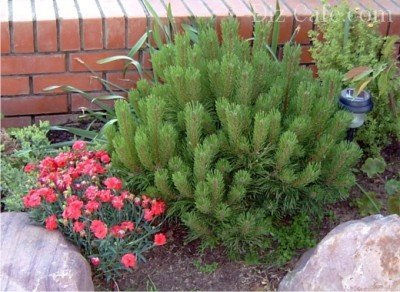

In small areas, different types of dwarf pine get along well, which stands out for its winter hardiness and ability to withstand snow loads
Among the crops that are more damaged than others in winter, the leading ones are tueviks, fir (except for Siberian and Vici), metasequoi, cypresses and cypress trees. In areas with a harsh climate, it is better not to plant these crops or tune in to the fact that every winter they will have to be protected from frost.
The list of the most unpretentious conifers includes:
- Ate (except for East and Brever);
- Cedars;
- Larch (except Western);
- Pines (except Thunberg);
- Junipers (except for Turkestan and Zeravshan);
- Tsugi;
- Western thuja.
The rest of the varieties need to be selected taking into account the length and severity of your winters.
An overview of the best varieties of ornamental shrubs for arranging a garden here: https://enn.imadeself.com/ozelenenie/dekorativnye-kustarniki-dlya-sada.html
Why does thuja bark crack in autumn
Breaks in the bark occur during the active growth of the cambium, which is located between the bark of the ephedra and the wood. Through the cracks formed on the bark, a viral and fungal infection enters the wood, which can quickly cause the death of an ornamental culture.
To restore the health of the plant, it is necessary to completely stop the application of complex fertilizers and growth accelerators, and also be sure to add monopotassium phosphate to the trunk circles, or a mixture based on 15 g of potassium sulfate and 40 g of superphosphate, which will stop the rapid growth processes. It is recommended to treat cracks in the bark with a solution consisting of 15 ml of fufanon and 50 g of Abiga-Peak, diluted in a bucket of warm water. At the final stage of processing, the cracks are cleaned and covered with garden varnish.
Use in landscape design
Danica looks advantageous in a composition with columnar or ovoid conifers, creating a balanced triangle according to the rules of the "golden ratio".
This spherical thuja is perfectly combined with ground cover and creeping flowering perennials, roses, acting as a solo plant.
Tuyu is used as a low dense curb near paths or along the boundaries of zones within the site.
Low-growing unpretentious annuals:
- Marigold;
- Petunias;
- Ageratum;
- Lobelia planted in an array around the plant or along the perimeter of its near-stem circle favorably set off the shiny needles and emphasize the exquisite shape of the thuja.
Features of thuja care in the fall and preparation for winter - general tips and tricks
The quality of autumn care for thuja depends on how the coniferous tree will survive the winter and will look like next spring.
So, among the main measures for preparing thuja for winter are the following:
- watering;
- top dressing (if necessary);
- treatment from diseases and pests (if there are concerns about their presence);
- sanitary pruning (mandatory cleaning of the crown from old yellowed and dried needles) and shaping haircut (if required);
- mulching and shelter for the winter (protection from snow and sunlight).
Video: caring for thujas in the summer-autumn period and preparing for winter
Watering
Regular watering you need to provide the thuja growing in the region, which is characterized by dry autumn. Before the onset of frost, watering should be especially abundant (water charging irrigation): the roots will be saturated with moisture for a long time, a wet earthen lump will freeze longer, which will save the rhizome from freezing temperatures, as a result, the thuja will be more resistant to changes in temperature regimes in winter. If autumn is full of rains, the coniferous tree is practically not watered additionally (except for the final water-charging irrigation).
Top dressing
For better wintering, it will not be superfluous to apply autumn fertilizer under the thuja, although if in the spring you have already given a complex fertilizer of prolonged action, then you do not need to additionally feed.
Worth knowing! Autumn fertilizer is a fertilizer that contains a high content of phosphorus and potassium. You can purchase both a special fertilizer for conifers and a regular one marked "autumn".
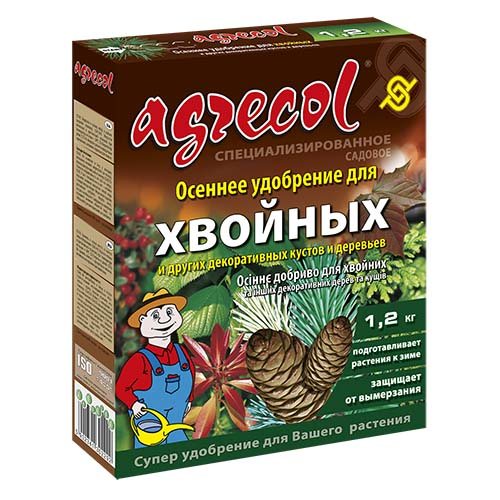

Treatment against diseases and pests
In the autumn, when preparing thuja for winter, it will be good to do preventive treatment of the ephedra from diseases and pests before sending it for the winter.
Advice! It is advisable to carry out even 2 treatments: the first - from diseases and, accordingly, the second - from pests.
- From fungal diseases (in particular from rust) - Copper sulfate, Bordeaux liquid(30 g per 10 liters - for treatment, 10 g per 10 liters - for prophylaxis) or with a special drug Hom or Abiga-peak (based on copper oxychloride), Acrobat MC.
- From pests (especially aphids) - Actellik, ordinary Fufanon or Fufanon-Nova, Rogor, Karbofos, Confidor, Decis (according to the instructions).
How to choose a covering material
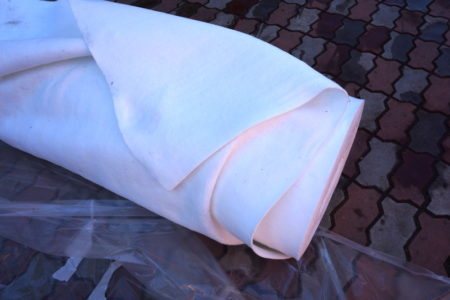

Choose the material for covering the thuja depending on its throughput, it must be high and allow air to penetrate inside. It is strictly forbidden to take material that does not allow air to pass through, for example, cellophane film. A greenhouse effect will develop under it, as a result of which the tree will begin to rot, shed the needles and become sick. The best material for a winter shelter is:
Choose a material with a white color, in addition to heat, it will reflect the sun's rays from the tree, thus the needles will not "burn". Therefore, if you chose a black roofing felt for shelter, wrap a white sheet or duvet cover over it.
Pruning thuja in the fall
As such, autumn pruning for the winter is not required. Another thing is that you should definitely clean the tree from yellowed old needles and spend preventive pruning (cleaning), i.e. remove diseased or dry, dead branches with pruning shears, cutting them to the very base.
If you form thuja (for example, a ball), then in this case you need to regularly correct her shape and cut her hair (cut out the branches that went "somewhere wrong").
Note! The main rule for pruning thuja is to cut it a little, but regularly (no more than 1/3 of the branch at a time). The bottom line is that if you miss the moment and the branch grows very much, then you will have to cut a lot and it will be easy to make a mistake, which will result in a hole in the crown that will overgrow for a long time.
Important! Desirable do not trim the hair in the first year of planting: let it calmly settle down in a new place, and next year start forming the crown.
Naturally, if you do not cut the thuja at all, then it can overgrow, because of which it will be poorly blown out and illuminated inside due to excessive thickening, which will certainly lead to sad consequences in the form of fungal diseases. Therefore, periodically you also need to perform thinning pruning, removing thickening branches.
Interesting! Tuya Smaragd independently acquires an almost perfect shape and does not need any haircut. But Tue Brabant, for example, requires a regular haircut, without which her crown becomes loose and empty, in other words, the ephedra looks unsightly.
Concerning terms of pruning thujathen the best time is it's late spring - early summerwhen the buds have just blossomed and young shoots have appeared, or late summer - early autumnwhen the tree is already preparing for winter.
Advice! Pruning should only be done in dry weather. If you do this in the rain, then all kinds of diseases can get into open wounds.
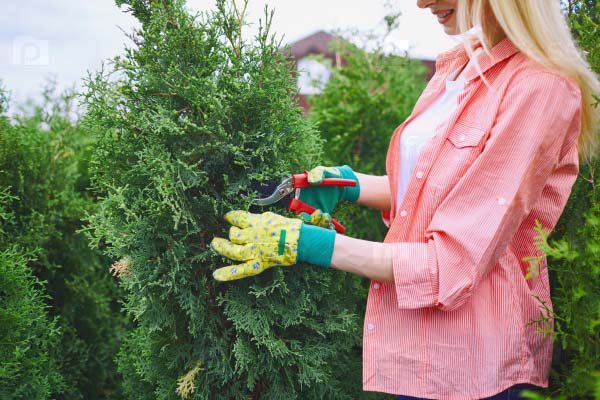

Video: how to crop the autumn, spring or summer
Brief information on the variety
- Color: dark green.
- Height: up to 80 cm.
- Crown width: up to 100 cm.
- In which regions is it growing: throughout the territory of the Russian Federation, except for the Far North.
- Landing features: in the sun, in group compositions - at a distance of at least 50 cm from neighboring plants.
- Immunity: to fungal diseases with proper agricultural technology.
- Life span: up to 200 years.
What to do if thuja turns yellow in autumn
Thuja needles can turn yellow in the fall for a natural reason - due to the loss of chlorophyll, a substance that provides food for the needles. They turn yellow, dry out and die, and then new green needles appear in the same place. it normal natural life cyclethat happens to thuja every 3-6 years.
Also, at the end of autumn, thuja needles may turn yellow due to natural defensive reaction of ephedra to a cold snap. ZThen she herself will turn green again.
Moreover, this (yellowing due to stress) will surely happen if the thuja does not have time to adapt to a new place when planting in early autumn or late summer.
When is the best time to hide
You need to close a tree in different regions in different ways for the winter. It depends on the onset of cold weather in a particular region, on the length of winter and on its average temperature. So, in the southern strip, the tree does not have to be covered for the winter. It grows quietly both in the summer cottage and in the forest. But for other regions, in order to preserve thuja in winter, you need to make a little effort.
Middle lane
Cooling in the middle lane begins in late October or early November. At this time, when there is still no snow, a 5-centimeter layer of mulch is laid near the tree trunk circle, covered with spruce branches and the culture is left to winter. Around the second part of winter, from the end of January, sun-reflecting screens are installed next to the tree to protect the needles. There is no need to wrap the crown with agrofibre, since the temperature in the Middle Lane rarely drops below +20 degrees, and overheating is dangerous for a tree.
Choice of materials
Thuja bags for the winter will not be difficult to purchase. There is a huge selection of covering materials on the modern market. First of all, you should pay attention to:
- burlap;
- gauze;
- tulle;
- cotton;
- polypropylene bags;
- roofing material;
- polymer mesh;
- kraft paper.
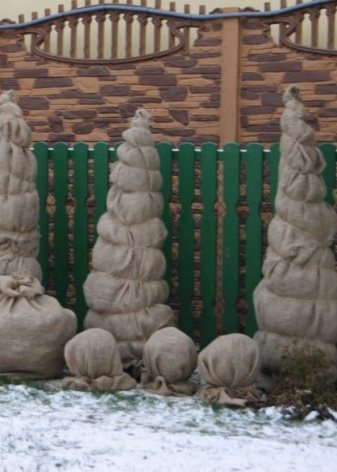

Experienced gardeners advise against covering evergreen shrubs with cellophane or polyethylene. These materials create a "greenhouse effect" that leads to the death of plants. Note that it is important to use non-woven materials that are breathable and protect from direct sunlight. It is advisable to purchase white bags.
In addition to protecting the crown, it is necessary to take care of the wintering of the thuja roots. There are several preparation options.
- The soil is mixed with the foliage. Such a "blanket" perfectly retains moisture at the root system, and humus will become an excellent plant food.
- Mulching with peat, sawdust or coniferous bark. Layer thickness - at least 10 cm.
- In addition, spruce branches are placed on the organic layer, which is removed with the arrival of heat. This moment is especially important for young trees, since their root system has not yet matured. Lapnik is able to protect the plant from "severe" frosts. Also, before warming, the thuja must be watered abundantly.
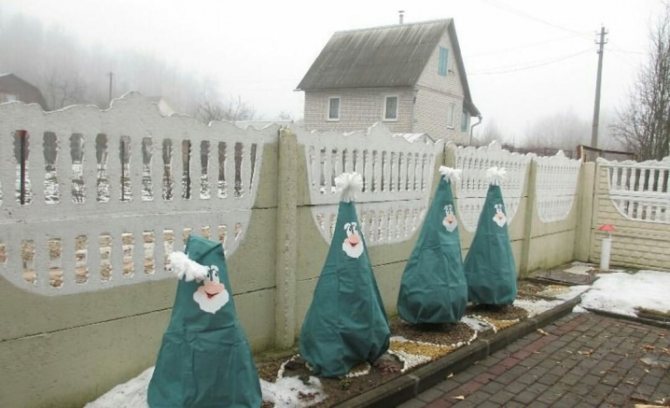

How to feed thuja in spring so that it does not turn yellow?
Before taking action, it is necessary to identify the reasons for the yellowing of thuja:
- Burns - in winter, the sun, reflecting off the snow cover, burns the weakened scaly leaves. To preserve the needles, in February, the plant is covered with gauze or a mosquito net.
- The spread of diseases or pests - it is necessary to carefully examine the crown, remove injured branches, and select debris. The appearance of yellow ulcers indicates the presence of a thuja false shield. If you do not take action, the entire trunk will soon turn yellow, the thuja will die. The plant is treated with insecticides - Aktellik, Rogor, Oksikhom. For preventive purposes, it is sprayed with a solution of Bordeaux liquid twice a year.
- Root decay - thuja loves moisture, but does not tolerate stagnant water well. It is planted only in a well-drained area. With an excess of moisture, the needles turn yellow, mold appears. If the plant has not been in the water for long, the damaged branches are cut off, the crown is treated with an antifungal agent. In the case of a close occurrence of groundwater, a transplant is required to another part of the garden, otherwise the tree will die.
To accelerate the recovery of needles, growth stimulants are used. At the same time, the plant is fed with a complex fertilizer for conifers. The biostimulator Ecogel-Antistress demonstrates a good effect. It accelerates growth, increases disease resistance, and triggers internal defense mechanisms.
Types of the most common mistakes
Inexperienced gardeners, who have never encountered the cultivation of a crop, immediately make many mistakes. As a result, the tree cannot stand them and over time either dries up or decays. Here are the options for the most common mistakes from agricultural practice:
- for the winter, the crowns of young trees are left uncovered;
- use fertilizers that are intended for deciduous trees (nitrogen complexes);
- do not cover the needles with sun screens;
- take cover too early.
An important step in the development of a tree is crown formation. If it is incorrectly laid, then the plant immediately loses its appearance. Therefore, after the shelter is removed, the thuja must be cut off. For pruning, take a pruner, it is convenient for them to work. First of all, remove from the top and middle part of the tree dry and diseased branches with yellow needles, they are already dead. If the crown is too thick, discharge it a little. This will increase the breathability of the tree and also reduce the risk of pests attacking the crop. So that your thuja grows better not upward, but in width, cut off part of the top, trimming the top helps to stimulate the lateral shoots, they are activated. There are 3 types of thuja pruning:
- spiral. The most common form for cutting thuja. in general, the tree resembles a large cone, its top will be narrowed;
- spherical. The option is suitable for the formation of low crowns. The plant looks great in the summer cottage, in the winter garden;
- topiary. The crown is formed in the form of any geometric shape: rhombus, square, ball. In garden stores, metal frame forms are sold for laying the crown, according to which they are subsequently pruned.
Autumn top dressing technology
Basically, autumn feeding is carried out in summer... It is possible to introduce it in September or October only where winter comes late and the climate is quite mild.


Top dressing in September-October is possible in mild climates
When introduced in the autumn, young shoots grow actively, which is highly undesirable, since they will not have time to ripen before winter and will freeze.
The final is made in the middle of August... In the summer, they are brought in in order to help the bush gain strength and prepare for wintering. It is also necessary to use organic fertilizers once a season.
In the autumn season, it is recommended to feed:
- Complex fertilizer for conifers to improve growth. These preparations provide the plant with a good appearance;
- Organic... They help to quickly saturate the soil with the necessary nutrients. These include:
- peat;
- slurry manure;
- compost.
Protection from pests and diseases
Bordeaux liquid and copper sulfate have proven themselves well for these purposes. You can also use sophisticated modern means, for example - "Actellik".
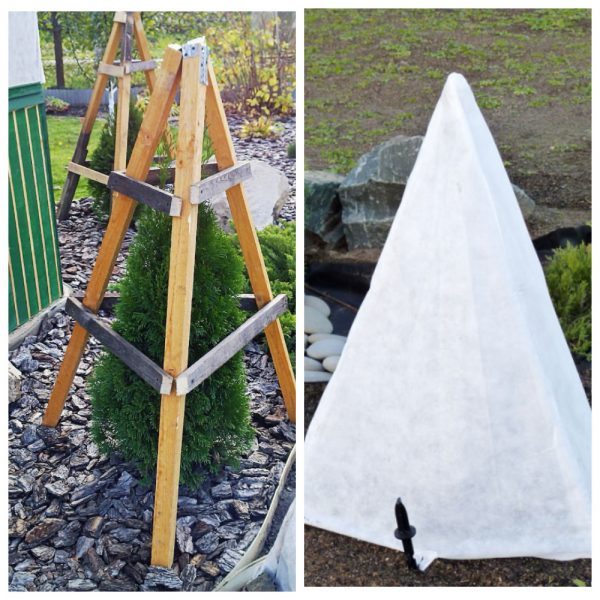

But folk remedies, like spraying a tree with herbal infusions, are completely unsuitable for autumn preventive treatment.
They are simply too weak for this (although they can be quite effective in the spring and summer seasons).
Reasons for hiding
As a rule, young immature trees need "winter clothing". Their branches are still rather weak, and the shoots are thin.They can break under the weight of snow. In addition, the root system of an annual thuja, propagated by cuttings, is on the surface - a severe snowless winter will destroy it. Also, the adhesion of snow leads to a curvature of the crown and sprinkling of needles. Burns are another negative factor in the wintering of thuja. If the crown is exposed, then the sun's rays begin to stimulate the growth of shoots, and the roots of the plant, meanwhile, are in "hibernation". As a result:
- the color of the thuja changes;
- needles fall off;
- shoots lose their usual shape.


Thus, the right shelter will help the tree survive the winter outdoors.
Industrial feeding for thuja
Biohumus-based preparations are a good addition to the diet of conifers. They provide protection against fungal spores and nutrition. Fitosporin-M and Fitosporin-K are often used. The preparations contain potassium and magnesium. The solution is prepared according to the instructions. It is better to process the conifers in the spring. Root watering or spraying can be used.
Autumn feeding of thuja actually begins in the middle of summer. The most common fertilizers for thuja are:
- Stimovit;
- Green Guy for needles;
- Embiko;
- Novofert;
- Royal Mix Grane Forte;
- Green food for conifers.
In addition to these dressings, you can use fertilizers for thuja with magnesium. Magnesium deficiency can lead to the death of needles and yellowing of the needles. It must be remembered that too acidic soil reduces the ability to absorb magnesium.
Construction of a frame for sheltering a thuja
This method is hardly suitable for tall trees. But for a medium-sized plant, it is quite acceptable. Such a shelter, if desired, can be done with your own hands. For example, drive several long sticks or twigs around the circumference of the tree.
Above the thuja, they can be tied together. Thereafter the material is pulled onto the base... Beforehand, the branches of the bush must be tied with a rope, but not tightly. A shelter in the form of a hut is good because snow will not accumulate on the surface.
To protect young plants from strong wind, so that it does not damage the crown, you can dig in a pole or stake parallel to the trunk and carefully tie a tree to it. The frame, although a rather labor-intensive construction will reliably protect the plant from the wind of frost and burns.
It is not necessary to make a shelter yourself, a ready-made structure can be bought in a store. Do not throw snow over the top of the shelter, otherwise the needles can resist. For the same reason, it is not advisable to use polyethylene or blankets as a shelter.
With such insulation, the plant can first support it, and freeze when severe frosts come. It is not necessary to tighten the plant tightly, it is important that air circulated between branches.
In adult specimens of thuja, only the very top can be sheltered from the sun. If you properly ensure the wintering of thuja, it stay healthy and beautiful... Such a plant will adorn any site.
Each plant is a living organism that requires an individual approach to the choice of activities aimed at caring for it. Some plants need to be given a minimum amount of time, they are unpretentious and do not require large expenses from you.
And there are plants that are not so easy to grow. For example, caring for thuja in winter consists of a set of activities that it is advisable to carry out in full in order to keep the plant healthy and beautiful.
It is this issue that we will pay attention to in this article, because thuja is one of the most popular species that many gardeners prefer to use in landscape design.
The ways
Preparation of thuja for winter begins in the fall, before the first frost and snow. The simplest option is bags of a suitable size, which are fixed with twine. An adult plant with strong roots is enough to wrap with a strong rope. Another way to hide high varieties of thuja involves the construction of a frame. It is not difficult to make it - just drive in three metal pins over the top of the thuja (crosswise) and fasten. Then cover the frame with a non-woven fabric. Special shields that create shade will perfectly protect from the spring sun. Low-growing shrubs can be covered with wooden boxes. Snow from "insulated" trees must be shaken off periodically.


Many gardeners plant evergreen thuja in tubs. In winter, the plants are taken indoors or covered with non-woven fabrics. As a rule, a drain is installed at the bottom of the container, which is great for keeping moisture in the pots. It is enough to water the plant and cover it with a cotton bag, securing it around the trunk with wire or rope. It is important to know that a coniferous tree cannot survive the winter in a dark and damp room. In winter, certain conditions are necessary for thujas growing in tubs.
- The optimum temperature of the content should not exceed +5 degrees. If the thermometer in the room drops to -3, then the pots are additionally insulated.
- Regular watering. In winter, the soil in the tubs should not be allowed to dry out. This will lead to yellowing and shedding of the needles of the tree.
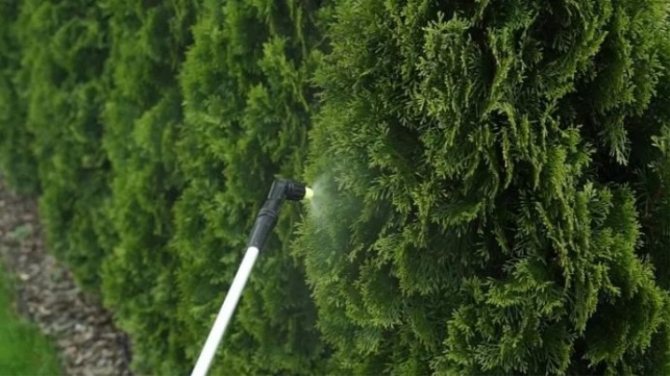

Also, thuja in containers winters well on a glazed balcony. Taking care of the plant will not be difficult. The tree will be able to receive the necessary lighting and fresh air. Before the onset of frost, the plant is abundantly watered and wrapped with kraft paper. During the winter, water is periodically poured into the bowls under the pots. The permissible room temperature should not exceed +12 degrees.
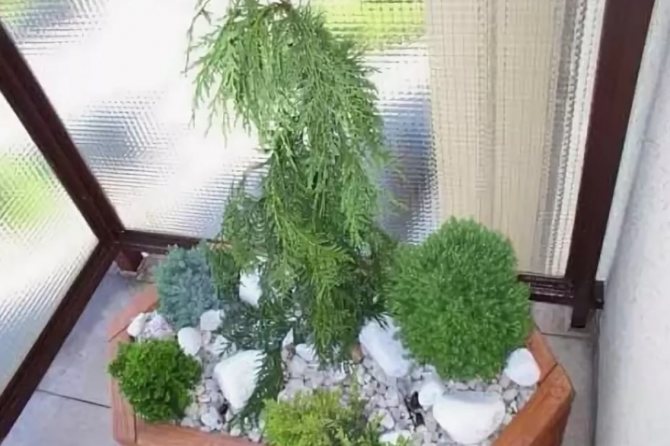

Fertilization rules
Fertilization in the fall is performed:
- if the soil needs improvement;
- when transplanting plants;
- for quick saturation of the soil with useful substances.
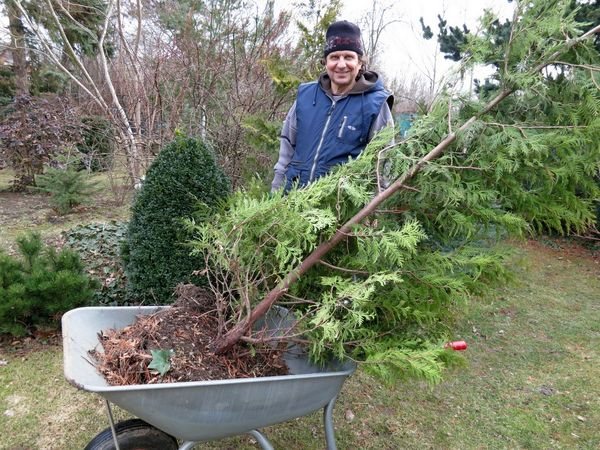

Top dressing is necessary when transplanting thuja in the fall
For this purpose, growth stimulants, special complex fertilizers for conifers are introduced into the soil. When applying fertilizers, the following recommendations should be taken into account:
- Fertilizers must be applied after a certain period of time. Between the introduction of fertilizing with various microelements must pass 14 days.
- Before fertilizing, it is necessary to water the soil around the plant in a day. Top dressing in dry soil will burn the root system.
- Before making fertilizing from different manufacturers, it is recommended to carefully read the composition, so as not to introduce the same microelements twice. This can lead to oversaturation.
It is necessary to carry out top dressing by filling up the soil... To do this, you can use:
- bone meal;
- ash;
- peat;
- compost.


Bone flour
This bedding will not provoke the growth of young shoots in winter... Mature plants do not need additional feeding.
If the soil is saline, liming is necessary. Gypsum is introduced into the soil and dug up. In September or October, quicklime must be added to the podzolic soil.
Problems of growing thuja Danica
Gardeners may be faced with the fact that a bright beauty suddenly begins to turn yellow. This can be due to several factors.
- Fusarium is the most common cause. The growth of soil fungi begins if the plant is not properly watered. To correct the situation, it is necessary to treat the crown and soil with a solution of any fungicide (0.2%). Kartocid or Fundazol will do. To increase the immunity of thuja, it is worth treating with Zircon.
- Sometimes the twigs begin to turn brown and then die off. This is due to the fact that the bush was infected with a fungus. It is necessary to sprinkle the bush with lime, remove all affected shoots. And at the end of summer, Fundazol is treated with an interval of 2 weeks.
- Pests of thuja Danica can also interfere with normal development. Sometimes the needles are covered with white dust, this is an attack of thuja aphids. Rogor, Karbofos and other chemicals can be used against it.
- Yellowish-brown ulcers on the bark indicate the appearance of a thuja false shield.For prevention, the trunk is smeared with special glue, it does not allow the caterpillars to multiply. If they have already appeared, they carry out processing with Aktellik.
Mycorrhizal preparations for thuja
Mycorrhizal vaccines can be used in addition to fertilizers. The preparations contain mycorrhizal fungi, which have the following effect on plants:
- increase the absorbency of the root system;
- improve water supply;
- reduce sensitivity to environmental stress;
- increase resistance to fusarium, late blight and other diseases;
- stimulate root growth;
- increase the availability of nutrients.
What a tree
Rod tui has 5 types:
- Korean;
- folded / giant;
- Japanese / standish;
- western;
- Sichuan.
Korean thuja in the climate of Russia can only grow in a greenhouse. It is not used to decorate outdoor gardens.
Sichuan thuja is an endangered endemic to China. The plant is very rare and is not used for ornamental plantings.
Folded thuja
The folded thuja has an additional name: red cedar. Often the definition of "Canadian" or "Western" is added to this name. This is a powerful tree. At the borders of the range in unfavorable conditions, folded thuja grows in shrub form.
The folded thuja is cultivated as an ornamental tree in parks and gardens. For decorative purposes, three forms of this type are used:
- with dark green needles;
- with a "weeping" crown;
- with a cylindrical crown.
Propagate this tree by seed.
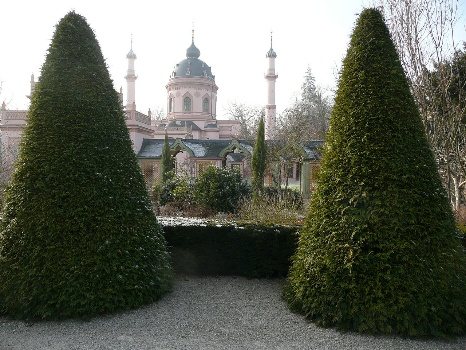

Japanese thuja
Under natural conditions, it grows up to 18 m. The crown is cone-shaped, loose. With candelabra branches. At home, thuja is grown for the sake of wood. In Europe, they are used for decorative purposes.
Western thuja
Native to North America. It is a frost-hardy plant that can withstand cold temperatures down to -36 ° C. In parks, squares, in summer cottages, it is planted because of its decorative appearance.
Western thuja propagates by green cuttings and seeds. For germination, seeds require mandatory stratification. The time at which you need to plant thuja depends on the breeding method.
Lack of micronutrients
It is possible to determine what components are missing in the soil by the appearance of the thuja. With a lack of phosphorus, the ends of the sheets acquire a red tint. The iron deficiency is evidenced by the light yellow tint of the branches, magnesium and potassium - yellowing of the crown. If few young twigs grow during the growing season, there is not enough nitrogen.
With an excess of nitrogen, young shoots grow, which do not have time to ripen before winter. In the cold, they freeze. Therefore, fertilizers are applied in moderation.

